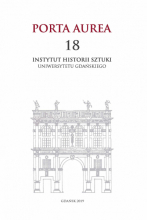Model do medalu Daniela Placotomusa w kontekście medali osobistych w XVI-wiecznym Gdańsku
Abstrakt
Personal medals, originated in 15th century Italy, became popular in Gdańsk in the course of the following century. Already in 1522–1532, Jan Dantyszek was commemorated in five medals. In 1544–1599, seven medals and two medallic models were commisioned for the residents of the city: Jorg Schewecke, Johann, Hans and Jacob Connert, Marcus Koehne-Jaschke, Catharina Placotomi, Jacob Schachmann and Hans Schwarzwaldt.
The current article is focused on the hitherto unknown model for the medal of Daniel Placotomus (c. 1566–1616). Carved in Solnhofen sandstone in 1594, it commemorates the fourth child of Johann Placotomus (1514–1577), a distinguished medic, pharmacist, and pedagogue active in Gdańsk from 1550. The study presents a reconstruction of the biography of Daniel Placotomus, a relatively little known member of the Placotomus family and seeks to establish motivation behind the commission of his likeness. The sandstone portrait is analysed in the context of the 16th century medallic portraits of Gdańsk residents and in relation to the remaining portraits of the members of the Placotomus family.
Downloads
Bibliografia
Bainton Roland H., Obitz Marion, Frauen der Reformation. Von Katharina von Bora bis Anna Zwingli. 10 Porträts, Gütersloh 1995.
Börner Lore, Deutsche Medaillenkleinode des 16. und 17. Jahrhunderts, Leipzig 1981.
Cieślak Katarzyna, Kościół – cmentarzem. Sztuka nagrobna w Gdańsku (XV–XVII w). „Długie trwanie” epitafium, Gdańsk 1992.
Cupperi Walter, Beyond the notion of German medal. Some cases of transnational practice [w:] Wettstreit in Erz. Porträtmedaillen der deutschen Renaissance, hrsg. von Walter Cupper, Mallin Hirsch, Anette Kranz, Ulrich Pfisterer, Berlin 2013, s. 81–89.
Drygaś Aleksander, Placotomus (właść. Brettschneider) Jan [w:] Słownik biograficzny Pomorza Nadwiślańskiego, t. 2, red. Stanisław Gierszewski, Gdańsk 1992, s. 477–480.
Dutkowski Jarosław, Motywy idei mieszczańskich na monetach, medalach i żetonach gdańskich od końca XVI do połowy XVIII wieku w Gdańsku, praca doktorska napisana na UG pod kierunkiem prof. dr hab. Krzysztofa M. Kowalskiego, Gdańsk 2007.
Greene Thomas W., Renaissance medals in relation to antique gems and coins, „The Numismatic Chronicle and Journal of the Numismatic Society” 1885, vol. 5, s. 73.
Habich Georg, Die Deutschen Schaumünzen des XVI Jahrhunderts, München 1924–1932.
Jackowska Krystyna, Szarszewski Adam, Paluchowski Piotr, Portrety gdańskich lekarzy (XVI–XVIII w.), Gdańsk 2015.
Liermann Elke, Studentische Fechten im frühneuzeitlichen Freiburg / Br. [w:] Frühneuzeitlische Universitätskulturen. Kulturgeschichte Perspektiven auf die Hochschule in Europa, hrsg. Barbara Krug-Richter, Ruth E. Mohrmann, Köln–Weimar–Wien 2009, s. 31–40.
Morka Mieczysław, The beginnings of Medallic Art in Poland during the Times of Zygmunt I and Bona Sforza, „Atribus et Historiae” 2008, vol. 29, No. 58, s. 65–87.
Nowak Zbigniew, Szafran Przemysław, Księga wpisów Gimnazjum Akademickiego 1580–1814, Warszawa–Poznań 1974.
Nowaliński Karol, Medalierstwo gdańskie XVI–XVIII wieku, „Przegląd numizmatyczny” 1997, t. 4, nr 19, s. 6–13.
Otto Maria, Sztambuch Petrusa Himmerleicha [w:] W gdańskim ogrodzie muz. Gimnazjum Akademickie w Gdańsku wobec kultury starożytnych Greków i Rzymian, red. Maria Otto, Jan Pokrzywnicki, Pelplin 2016, s. 214.
Pałubicki Janusz, Rzeźba kamienna w Gdańsku w latach 1517–1585, „Gdańskie Studia Muzealne” 1981, t. 3, s. 175–196, 391–412.
Quint David, Duelling and Civility in Sixteenth Century Italy, „I Tatti Studies in the Italian Renaissance” 1997, vol. 7, s. 242–252.
Rühle Siegfried, Die Danziger Personenmedaillen, „Zeitschrift des Westpreussischen Geschichtsvereins” 1930, Bd. 70, s. 141–175.
Scher Stephen K., Introduction [w:] The currency of fame. Portrait Medals of the Renaissance, ed. Stephen K. Scher, New York 1994, s. 13–16.
Sobecka Anna, Bursztyn bałtycki w kulturze [w:] Bursztyn bałtycki – skarb Zatoki Gdańskiej. Bursztyn bałtycki w nauce, kulturze, jubilerstwie i promocji regionu, red. Ryszard Sadziewski, Ryszard Pytlos, Jacek Szwedo, Gdańsk 2018, s. 76–93.
Sobecka Anna, Malarstwo nowożytne w kościele Mariackim w Gdańsku [w:] Kościół Mariacki w Gdańsku, red. J. Friedrich, t. 2. Wyposażenie, Gdańsk 2019, s. 138–167.
Stahr Maria, Medalierstwo [w:] Aurea Porta Rzeczypospolitej. Sztuka gdańska od połowy XV do końca XVII wieku, t. 1, Eseje, red. Teresa Grzybkowska, Gdańsk 1997, s. 157–169.
Steguweit Wolfgang, Europäische Medaillenkunst von der Renaissance bis zur Gegenwart, Berlin 1999.
Weichbrodt Dorothea, Patrizier, Bürger, Einwohner der Freien und Hansestadt Danzig: in Stamm - und Namentafeln vom 14.–18. Jahrhundert, Bd. 1, Klausdorf 1988, s. 371.
Więcek Adam, Dzieje sztuki medalierskiej w Polsce, Kraków 1989.
Wittenberger Gelehrten Stammbuch. Das Stammbuch von Abraham und David Ulrich. Benutzt von 1549–1577 sowie 1580–1623. Herausgegeben durch das Deutschen Historischen Museum Berlin, bearbeitet von Wolfgang Klose, Halle 1999.

 Uniwersyteckie Czasopisma Naukowe
Uniwersyteckie Czasopisma Naukowe




